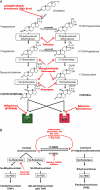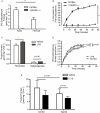Therapeutic manipulation of glucocorticoid metabolism in cardiovascular disease
- PMID: 19239478
- PMCID: PMC2697748
- DOI: 10.1111/j.1476-5381.2008.00047.x
Therapeutic manipulation of glucocorticoid metabolism in cardiovascular disease
Abstract
The therapeutic potential for manipulation of glucocorticoid metabolism in cardiovascular disease was revolutionized by the recognition that access of glucocorticoids to their receptors is regulated in a tissue-specific manner by the isozymes of 11beta-hydroxysteroid dehydrogenase. Selective inhibitors of 11beta-hydroxysteroid dehydrogenase type 1 have been shown recently to ameliorate cardiovascular risk factors and inhibit the development of atherosclerosis. This article addresses the possibility that inhibition of 11beta-hydroxsteroid dehydrogenase type 1 activity in cells of the cardiovascular system contributes to this beneficial action. The link between glucocorticoids and cardiovascular disease is complex as glucocorticoid excess is linked with increased cardiovascular events but glucocorticoid administration can reduce atherogenesis and restenosis in animal models. There is considerable evidence that glucocorticoids can interact directly with cells of the cardiovascular system to alter their function and structure and the inflammatory response to injury. These actions may be regulated by glucocorticoid and/or mineralocorticoid receptors but are also dependent on the 11beta-hydroxysteroid dehydrogenases which may be expressed in cardiac, vascular (endothelial, smooth muscle) and inflammatory (macrophages, neutrophils) cells. The activity of 11beta-hydroxysteroid dehydrogenases in these cells is dependent upon differentiation state, the action of pro-inflammaotory cytokines and the influence of endogenous inhibitors (oxysterols, bile acids). Further investigations are required to clarify the link between glucocorticoid excess and cardiovascular events and to determine the mechanism through which glucocorticoid treatment inhibits atherosclerosis/restenosis. This will provide greater insights into the potential benefit of selective 11beta-hydroxysteroid dehydrogenase inhibitors in treatment of cardiovascular disease.
Figures



Similar articles
-
11β-hydroxysteroid dehydrogenases: intracellular gate-keepers of tissue glucocorticoid action.Physiol Rev. 2013 Jul;93(3):1139-206. doi: 10.1152/physrev.00020.2012. Physiol Rev. 2013. PMID: 23899562 Free PMC article. Review.
-
Distribution of glucocorticoid and mineralocorticoid receptors and 11beta-hydroxysteroid dehydrogenases in human and rat ocular tissues.Invest Ophthalmol Vis Sci. 2000 Jun;41(7):1629-38. Invest Ophthalmol Vis Sci. 2000. PMID: 10845579
-
Glucocorticoids and cardiovascular disease.Eur J Endocrinol. 2007 Nov;157(5):545-59. doi: 10.1530/EJE-07-0455. Eur J Endocrinol. 2007. PMID: 17984234 Review.
-
11beta-Hydroxysteroid dehydrogenase in the brain: a novel regulator of glucocorticoid action?Front Neuroendocrinol. 1997 Jan;18(1):49-99. doi: 10.1006/frne.1996.0143. Front Neuroendocrinol. 1997. PMID: 9000459 Review.
-
Targeting 11β-hydroxysteroid dehydrogenases: a novel approach to manipulating local glucocorticoid levels with implications for rheumatic disease.Curr Opin Pharmacol. 2013 Jun;13(3):440-4. doi: 10.1016/j.coph.2013.03.003. Epub 2013 Mar 26. Curr Opin Pharmacol. 2013. PMID: 23540586 Review.
Cited by
-
Diuretic Treatment in Patients with Heart Failure: Current Evidence and Future Directions-Part II: Combination Therapy.Curr Heart Fail Rep. 2024 Apr;21(2):115-130. doi: 10.1007/s11897-024-00644-2. Epub 2024 Feb 1. Curr Heart Fail Rep. 2024. PMID: 38300391 Free PMC article. Review.
-
Xiaoyaosan prevents atherosclerotic vulnerable plaque formation through heat shock protein/glucocorticoid receptor axis-mediated mechanism.Am J Transl Res. 2019 Sep 15;11(9):5531-5545. eCollection 2019. Am J Transl Res. 2019. PMID: 31632527 Free PMC article.
-
New insights into the roles of glucocorticoid signaling dysregulation in pathological cardiac hypertrophy.Heart Fail Rev. 2022 Jul;27(4):1431-1441. doi: 10.1007/s10741-021-10158-x. Epub 2021 Aug 28. Heart Fail Rev. 2022. PMID: 34455516 Review.
-
Reciprocal regulation of 11β-hydroxysteroid dehydrogenase 1 and glucocorticoid receptor expression by dexamethasone inhibits human coronary artery smooth muscle cell proliferation in vitro.Mol Cell Biochem. 2011 Jan;346(1-2):69-79. doi: 10.1007/s11010-010-0592-5. Epub 2010 Oct 5. Mol Cell Biochem. 2011. PMID: 20922465 Free PMC article.
-
Glucocorticoids: Fuelling the Fire of Atherosclerosis or Therapeutic Extinguishers?Int J Mol Sci. 2021 Jul 16;22(14):7622. doi: 10.3390/ijms22147622. Int J Mol Sci. 2021. PMID: 34299240 Free PMC article. Review.
References
-
- Adamson AC, Tillman WG. Hydrocortisone. Br Med J. 1955;ii:1501.
-
- Adlersberg D, Schaefer L, Drachman SR. Development of hypercholesteremia during cortisone and Acth therapy. JAMA. 1950a;144:909–914. - PubMed
-
- Adlersberg D, Schaefer LE, Dritch R. Effect of cortisone, adrenocorticotropic hormone (Acth), and desoxycorticosterone acetate (Doca) on serum lipids. J Clin Invest. 1950b;29:795. - PubMed
-
- Adlersberg D, Schaefer LE, Dritch R. Studies on hormonal control of serum lipid partition in man. J Clin Endocrinol. 1950c;10:814–815. - PubMed
-
- Akao T, Akao T, Hattori M, Namba T, Kobashi K. Inhibitory effects of glycyrrhetic acid and its related-compounds on 3-alpha-hydroxysteroid dehydrogenase of rat-liver cytosol. Chem Pharm Bull. 1992;40:1208–1210. - PubMed
Publication types
MeSH terms
Substances
LinkOut - more resources
Full Text Sources
Other Literature Sources
Medical

